A favorite among summer residents for growing in a greenhouse is the “Babushkino Lukoshko” tomato.
Greenhouse tomatoes are popular among gardeners living in regions with difficult climatic conditions. Such areas are characterized by sudden changes in weather, heavy rains and fogs, which negatively affect the quality and quantity of the future harvest. To prevent negative consequences, Siberian and Ural gardeners plant tomatoes in greenhouses or greenhouses. Shelters protect plants and provide adequate conditions for growth and development.
Let's take a closer look at one of the best greenhouse varieties - Babushkino Lukoshko, and learn the secrets of its cultivation.
Description of the variety
The salad variety Babushkino Okoshko is a mid-early variety that ripens in 90-100 days from planting. Tomato is highly resistant to common crop diseases and insect pests.
Distinctive features
Bushes indeterminate, are not limited in growth. The average height of the bush is about 1.8-2 m. The bushes are spreading, the foliage is dense, dark green. To obtain the best harvest, it is recommended to plant tomatoes in seedlings, having previously disinfected the seeds and prepared the soil.
Fruit characteristics and yield
The tomatoes are large, flat-round. The average weight of the fruit is about 300 g, but in some cases it reaches 700-800 g. The color is red, the surface is smooth and even. The marketability of tomatoes is excellent; Babushkino Lukoshko is often grown for sale. The taste is above average, the vegetable is excellent for making salads. Productivity is stable, from 1 sq. m summer residents collect from 10 to 12 kg of red tomatoes.
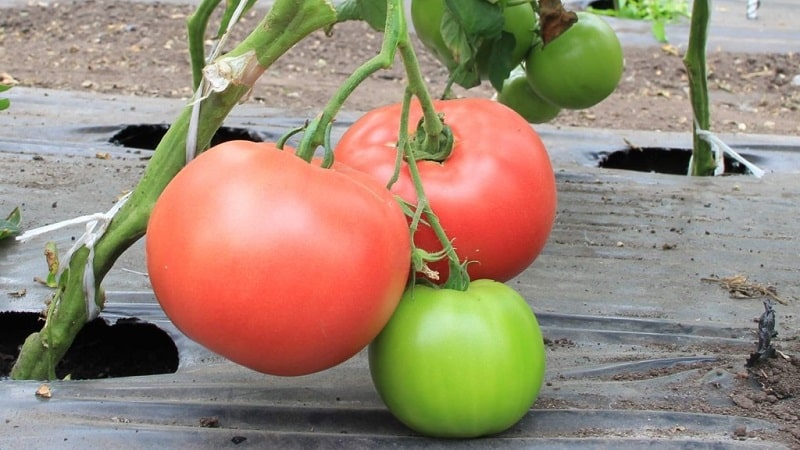
How to grow seedlings
Tomato seedlings are prepared 40-50 days before planting in the garden. Some gardeners turn to the lunar calendar for help. Let's take a closer look at what is required to prepare high-quality seedling material.
Seed preparation
Before sowing seeds must be disinfected. The simplest and most accessible method of disinfection is heating in the sun for 5-7 days. The seeds are laid out on the veranda or loggia in direct sunlight. Solar disinfection destroys dangerous pathogens and microbes on the surface. You can also carry out the procedure using a 2-3% solution of hydrogen peroxide. The liquid is heated to a temperature of 40°C, the seeds are placed in a fabric bag and dipped in peroxide for 7-8 minutes.
To test the seeds for germination, they are germinated. To do this, disinfected seeds are placed in damp gauze and put in a warm place. It is recommended to germinate seeds in a well-ventilated room where the air temperature should be at least 23°C. Non-compliance with temperature conditions and improper storage can affect the germination level of seeds. Therefore, before purchasing, it is advised to carefully inspect the integrity of the packaging and check the expiration date.
Container and soil
 Babushkino Lukoshko tomatoes are convenient to grow in plastic containers for seedlings. They are comfortable, lightweight and are sold at any gardening store. Pallets are purchased along with containers so that when watering water flowed out through special holes, and the seedlings did not dry out.
Babushkino Lukoshko tomatoes are convenient to grow in plastic containers for seedlings. They are comfortable, lightweight and are sold at any gardening store. Pallets are purchased along with containers so that when watering water flowed out through special holes, and the seedlings did not dry out.
It is convenient to place containers in pallets on a windowsill or loggia so that the sprouts receive more sunlight and heat. You can also plant seedlings in ordinary plastic cups or cardboard milk boxes. Before use, thoroughly wash the container and dry with a clean towel.
Gardeners use garden soil or ready-made compounds as soil. The advantage of the latter is that they are already disinfected in advance and equipped with nutrients. However, many people prefer to prepare the soil themselves, using peat or humus as fertilizer. For looseness, sawdust or purified river sand is added to such compositions. The soil is disinfected with a solution of potassium permanganate.
Sowing
Soil is poured into a clean container, holes 1 cm deep are made at a distance of 10-15 cm from each other. 1-2 seeds are placed in each, sprinkled with earth on top and watered with warm water. Before the first leaves appear, the container is covered with plastic wrap, which is then removed. For convenience, the seedlings are marked - the name of the variety and the date of planting are written.
Growing and care
Seedlings should receive at least 12 hours of sunlight per day. If daylight hours are short, additional lighting is provided using phytolamps or fluorescent devices. The first week, instead of traditional watering, spraying is used from a spray bottle. This is done so that the root system and foliage develop evenly. After 10-15 days, watering is organized using a pipette. It is important that the water gets directly under the root, bypassing the stems and leaves. Water only with warm water, not cold from the tap.
2 weeks after planting, tomatoes are fertilized with liquid organic matter. Chicken droppings or manure work great. The next feeding will be organized in 15-20 days. Bordeaux mixture or nettle infusion is used as a means of protection. Experienced gardeners recommend adding not only organic matter to seedlings, but also mineral complexes or growth stimulants.

How to grow tomatoes
The Babushkino Lukoshko tomato is recommended for growing in a greenhouse. To get a rich harvest, we will analyze in detail the secrets and recommendations of experienced summer residents.
Landing
Before planting tomatoes, carefully dig up the soil in the greenhouse and fertilize it. In addition, all debris, weeds and remains of old plants are removed from the beds. All surfaces (walls, windows) are wiped with a solution of hydrogen peroxide or Bordeaux mixture. These measures reduce the risk of future diseases and pests.
Small grooves are made in the prepared beds, the distance between them is at least 40-50 cm. Since the bush needs garter, a wooden peg is placed next to each hole. A seedling is placed in the hole, the stem is generously sprinkled with soil and watered. When transplanting seedlings, it is important not to damage the still fragile and weak stems of the plants.
Care
The key to proper care is timely watering. Every year more and more gardeners install a drip irrigation system on their plots. With the help of a convenient design, water gets directly to the root, which reduces the risk of spreading diseases. Approximately 1.5-2 liters of water are consumed per bush. The beds are watered by hand several times a season. Instead of ordinary water, use an infusion of nettle or wood ash. This method improves the taste of the fruit and protects it from pests.
Once every 2 weeks, tomatoes are sprayed with a whey solution or an infusion of onion peels. They do this to protect the bushes from Colorado potato beetles. Organic and mineral fertilizers are added to the soil three times a season. Particular attention is paid to nitrogen-containing, potassium and phosphorus preparations. Ammophos or bone meal are recognized as excellent remedies.

Features of cultivation and possible difficulties
After a month, the bushes are tied to a support. Otherwise, they may break under the weight of large and heavy fruits. The most common method of gartering is a support in the form of a wooden stick or peg. It is important not to tighten the knot tightly, as this will negatively affect the development of the bush. Next, experienced gardeners advise pinching the top to stop growth. At the same time, all side shoots are removed, as they interfere with the formation of large tomatoes.
Important! Before each watering, it is recommended to loosen the beds. Loosening improves the quality of the soil and saturates it with oxygen. Often loosening is combined with weed removal. Unwanted vegetation disrupts the microflora of the beds and slows down the growth of tomatoes.
Diseases and pests
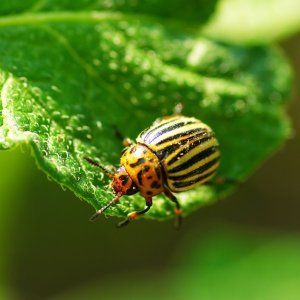 The most common tomato disease is late blight. A dangerous fungus occurs in greenhouses due to high humidity and heat. Therefore, it is important to ventilate the structure daily using special vents. Late blight appears as brown and yellow spots on the leaves.
The most common tomato disease is late blight. A dangerous fungus occurs in greenhouses due to high humidity and heat. Therefore, it is important to ventilate the structure daily using special vents. Late blight appears as brown and yellow spots on the leaves.
If measures are not taken in time, the tomatoes begin to rot and turn brown. Spraying with Oxychom or Maxim is recognized as an effective preventative against late blight.Also, sometimes root rot occurs in the beds, which occurs due to improper care and lack of vitamins. To prevent this, wood ash and watering with a solution of copper sulfate are used.
Among the pests, Colorado potato beetles and spider mites are noted. Bugs live on leaves and extract nutrients from plants. The drugs “Typhoon” or “Tornado” help get rid of them. If aphids or whiteflies have settled on tomatoes, whey-based sprays will come to the rescue.
The nuances of growing in a greenhouse
When growing, experienced gardeners recommend following some recommendations that will help you get a rich and tasty harvest:
- use only warm water for irrigation;
- thoroughly disinfect garden tools;
- regularly ventilate the greenhouse;
- do not over-moisten the soil, this can lead to the development of diseases;
- tie up and pinch bushes in time;
- pick ripe fruits on time, without overcooking.
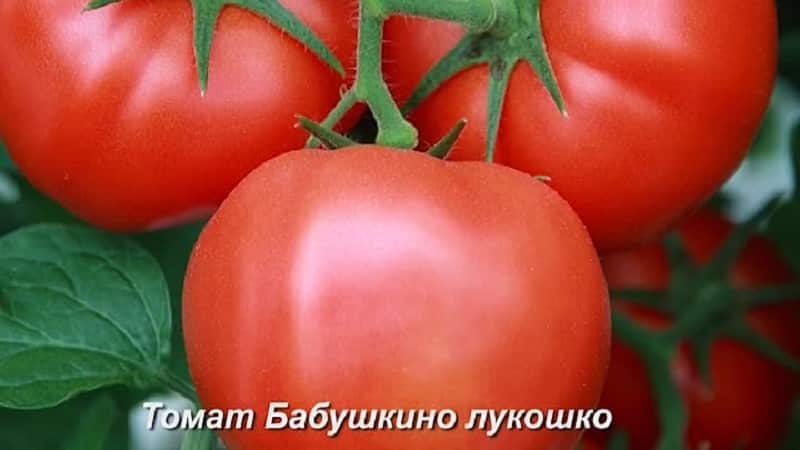
Harvesting and application
Tomatoes are harvested after they have acquired a firm and elastic structure. Some gardeners prefer to pick fruits at the stage of technical maturity, when the tomatoes are still light green in color. For long-term storage, tomatoes are wiped with a dry cloth and placed in a wooden box, which is covered with a clean cloth on top. An excellent place to store tomatoes is a dry cellar or basement.
Due to its attractive appearance, the Babushkino Lukoshko tomato is actively used to decorate the holiday table. The vegetable makes beautiful and tasty cuts, snacks and salads. The sweetish pulp goes harmoniously with soups and side dishes and complements the taste of meat and fish dishes.Tomatoes are used to prepare pickled preparations, pickled or canned products for the winter.
Interesting! They even make jam from tomatoes. True, this unusual delicacy is used as a sauce for meat. To add piquancy, mint or cinnamon is added to the jam.
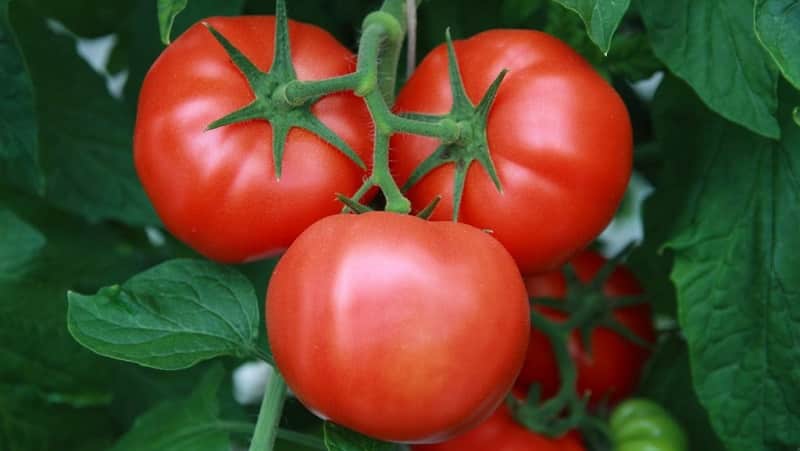
Advantages and disadvantages of the variety
The main advantage of the Babushkino Lukoshko variety is its commercial and taste qualities. The fruits have a pleasant pulp and contain many useful vitamins and microelements. Vegetables are often used to prepare dietary or children's dishes. The variety has increased immunity to diseases and pests, and is characterized by stable and high yields.
Among the disadvantages, they note the fact that tall bushes require mandatory staking and bush formation. The variety is demanding on soil composition and requires mineral and organic fertilizing.
Farmer reviews
To find out what other gardeners think about the Babushkino Lukoshko variety, let’s read several reviews from popular online forums.
Irina, Ufa: “I love large-fruited tomatoes, Babushkino Lukoshko is one of the best. I have never had any problems with the vegetable; I have been growing it for the fourth year in a row. The tomatoes are aromatic and tasty.”
Maria, Penza: “I always plant the variety in a greenhouse, so the yield is much higher. The bushes are unpretentious in care and require a minimum of attention. I recommend for landing."
Pavel, Moscow: “I planted this variety for the first time. The vegetable is not bad, but it is not suitable for whole-fruit canning; large tomatoes do not fit in a jar. The care is no different from others, the taste is average.”
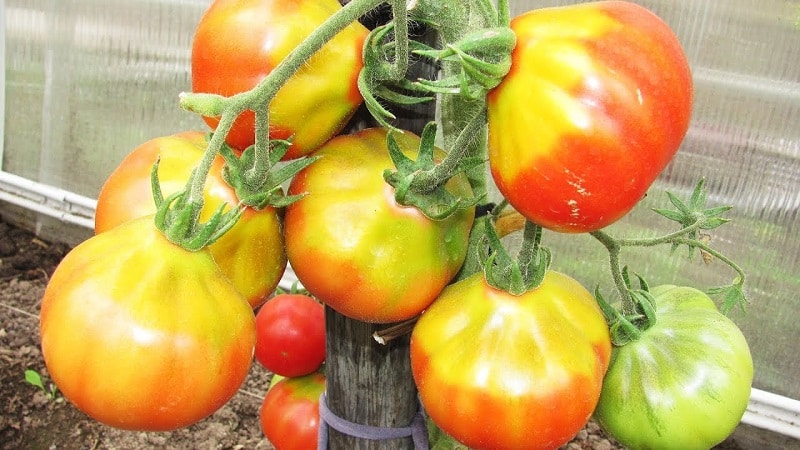
Conclusion
The Babushkino Lukoshko variety is valued for its large fruits and productivity.Tomatoes are used not only in cooking, but also in folk medicine and cosmetology. The vegetable contains vitamin C and folic acid, which have a positive effect on the condition of the skin and the overall immunity of the body. The variety does not require any special skills to care for, but some gardeners have difficulty forming a bush and tying it up. Otherwise, the beds are cared for according to traditional rules: watered once every 5-7 days, fertilized once every 2 weeks.